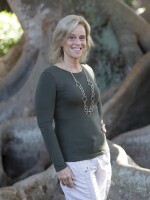Author and photographer Kirsten Hines takes readers on a visual and narrative journey into the ecology of Florida’s animals in her new book, Wild Florida.
WUSF's Cathy Carter recently spoke with the author about her travels around the state.
Tell us about your adventure Kirsten.
Well, 'Wild Florida' is me falling in love with Florida all over again. I had lived in South Florida and worked there for 15 to 20 years. But the reality is, I really hadn't spent that much time in Central or North Florida yet. I very quickly realized that that was a different ballgame. And I also realized most of my mammal photography had been very opportunistic. It's one thing to take pictures of a raccoon or whatever, when you bump into it. It's something entirely different when you're targeting the Florida panther that's endangered and very hard to find, or the Florida bear that's very wary of people and does everything they can to stay away from you. So, it ended up being a much bigger project that I had anticipated. But in that process, I understood Florida in a whole new light.

As you said, you traveled the whole state. So, what makes Florida so unique in terms of our wildlife?
Well, it's the biogeography of the state. The Panhandle has always been connected to North America. And so, it is actually a temperate biodiversity spot. So, for that land size, it has a higher number of species of turtles and fish and plants. We have huge diversity of salamanders there because the Appalachian Mountains are a global hotspot for that, but they really only stay in the Panhandle. Then in the Central Florida we have the Central Highlands. So that's an area of really high endemism, which means these are species that occur nowhere else in the world. So, the only endemic species of bird, the Florida scrub jay, for example, only occurs on those habitats. We also have the Florida scrub lizard, and we have a red widow spider, and there's all kinds of species that only live there. And then by the time you get down to southeastern Florida that's really down in the Caribbean. So having these three hot spots is very unique, very special, and we have a lot of different types of animals.
The Tampa Bay region isn't considered a biodiversity hotspot. But what did you find about Tampa Bay that makes this area unique?
You know, Tampa Bay itself is a very rich estuary. So, you have lots of fish, you have predators of those fish like dolphins, you have reddish egrets. And also because of the positioning of Tampa Bay, it's an amazing place for migratory birds. Fort DeSoto for example, the county park, is noted as being one of the best places in spring to go watch migrant birds and shorebirds, but even warblers and songbirds. Because of its geography, Tampa Bay is just a wonderful place to be able to see things like that.

In many of the essays in your book, you talk about conservation, what do you want readers to know about how important that is in terms of keeping our wildlife thriving?
Well, what's nice is that Florida is kind of ahead of the game in a lot of ways in that we have 30% of our natural areas already under protection. And so that's great. But it's one thing to have 30% as these separate little islands that aren't connected, but that doesn't really work when we have big species like the Florida panther, the black bear or even things that are considered smaller, but they still have surprisingly large home ranges, like the indigo snake. And so, these patches really need to be connected. And of course, people want to be in Florida. So, people are moving here at a really rapid rate. And we have a lot of development. And so, for the future of Florida, I think there's several things - one is coexistence is really important. We need to learn to live with nature and with our wildlife. We also need to be careful about making sure that we connect these natural areas that exist both by protecting natural areas that are already within that corridor, but if it’s what it takes, also recreating habitat to make sure those connections are there and viable.
Kirsten Hines will be giving a talk at Oxford Exchange Bookstore in Tampa this Sunday, Dec. 19.




